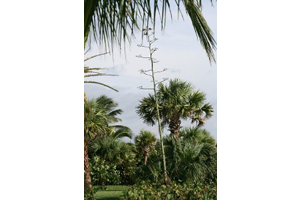Sabal palmetto gets its name from the Spanish word palmito or small palm. It is the state tree of North Carolina and Florida. Historically the large leaf buds of the Sabal palmetto were used in a cabbage-like salad. Harvesting of the terminal bud could kill the palm. The palm is also a source of delicious dark-amber honey. It is frequently used for landscape plantings. Sabal palmetto is native to U.S. and is in the Arecaceae (Palm Family).
Photo Credit: © Randolph Femmer (NBII LIFE)
Sabal palmetto
Common Name: cabbage palmetto
Plant Functional Group: Evergreen broadleaf
Class > Order > Family: Magnoliopsida > Arecales > Arecaceae
What does the species look like?
Sabal palmetto, or cabbage palmetto
, is a perennial, evergreen palm tree that can grow up to 90 feet high at maturity. The bark of cabbage palmetto is grayish to brownish, and its foliage is gray-green and fan-shaped. The palm sheds its older leaves as new leaves emerge. It has showy, fragrant, yellowish-white flowers and an abundance of shiny, black, fleshy fruits (drupes) that each contain one hard, brown seed. Cabbage palmetto grows along coastal wetlands in marshes and on sandy shores, wet hammocks, riverbanks, and coastal woodlands. It prefers sun or part shade and tolerates a variety of soils. It has low tolerance to drought but is salt and cold tolerant. Cabbage palmetto fruits and foliage provide food and cover for small and large mammals, terrestrial birds, insects, and even other plants. The flowers are pollinated by bees and other insects and are dispersed by water, wind, birds, and mammals.
Where is the species found?
States & Provinces
AL, FL, GA, LA, MS, NC, SC
Which phenophases should I observe?
Do you see...?
Flowers
Flowers or flower buds More...
How many flowers and flower buds are present? For species in which individual flowers are clustered in flower heads, spikes or catkins (inflorescences), simply estimate the number of flower heads, spikes or catkins and not the number of individual flowers.
Less than 3 3 to 10 11 to 100 101 to 1,000 1,001 to 10,000 More than 10,000
Open flowers More...
What percentage of all fresh flowers (buds plus unopened plus open) on the plant are open? For species in which individual flowers are clustered in flower heads, spikes or catkins (inflorescences), estimate the percentage of all individual flowers that are open.
Less than 5% 5-24% 25-49% 50-74% 75-94% 95% or more
Fruits
Fruits Sabal palmetto , the fruit is fleshy and berry-like and changes from green to black-brown or black.More...
How many fruits are present?
Less than 3 3 to 10 11 to 100 101 to 1,000 1,001 to 10,000 More than 10,000
Ripe fruits Sabal palmetto , a fruit is considered ripe when it has turned black-brown or black.More...
What percentage of all fruits (unripe plus ripe) on the plant are ripe?
Less than 5% 5-24% 25-49% 50-74% 75-94% 95% or more
Recent fruit or seed drop More...
How many mature fruits have dropped seeds or have completely dropped or been removed from the plant since your last visit?
Less than 3 3 to 10 11 to 100 101 to 1,000 1,001 to 10,000 More than 10,000
What do these phenophases look like?
There is currently no photoguide available for this species. If you'd like help us create one, use the guidance document and species template provided here . Then send it via email to education@usanpn.org when it is complete.
